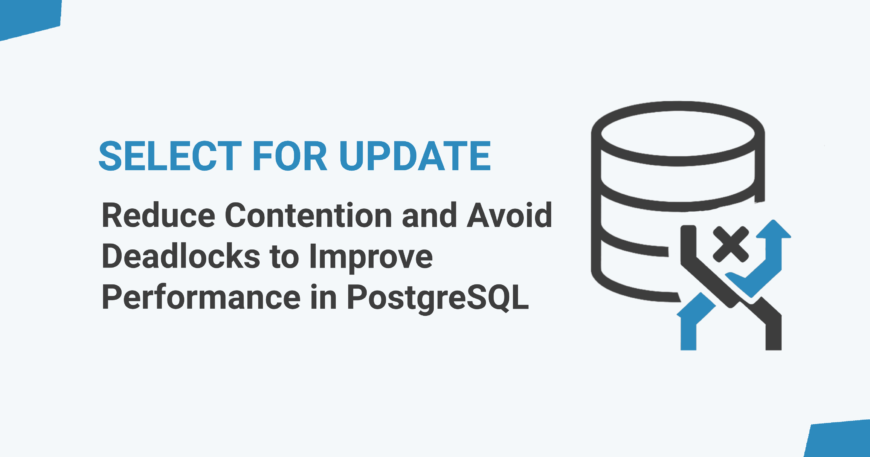Relational databases are at the heart of countless applications around the world, from high-traffic e-commerce websites to enterprise resource planning (ERP) systems and financial services. Concurrency management—where multiple database transactions operate on the same data simultaneously—is critical to getting good performance and avoiding problems like deadlocks or data inconsistencies.
When multiple transactions need to modify the same rows, ensuring data consistency can become tricky. A single wrong approach to locking can lead to suboptimal performance or even bring your application to a standstill as numerous transactions block one another. One tool in PostgreSQL’s arsenal to handle concurrency is SELECT FOR UPDATE. It allows you to lock specific rows before updating them, preventing other transactions from modifying those rows until your transaction completes.
In this blog, we will dive deep into SELECT FOR UPDATE in PostgreSQL. We will explore how it helps in reducing contention, avoiding deadlocks, and ultimately boosting performance when dealing with highly concurrent applications.
Table of Contents
- What Is SELECT FOR UPDATE?
- Why Concurrency Management Matters
- How SELECT FOR UPDATE Lowers Contention
- Common Use Cases
- How to Use SELECT FOR UPDATE Effectively
- Variations of Row Locking Clauses
- Avoiding and Resolving Deadlocks
- Hypothetical Case Study: Inventory System Under High Concurrency
- Performance Considerations
- When You Shouldn’t Use SELECT FOR UPDATE
- Advanced Tips
- Putting It All Together: A Step-by-Step Approach
- Conclusion
In PostgreSQL, SELECT FOR UPDATE is a way to lock rows at the time you fetch them. This prevents other transactions from modifying or even locking these same rows until your transaction either commits or rolls back. It is essentially a row-level lock that ensures your transaction holds an exclusive grip on the fetched data.
The basic syntax looks like this:
SELECT * FROM table_name WHERE condition FOR UPDATE;
When you run this query, PostgreSQL identifies all rows that match the WHERE condition. It will lock those rows exclusively for your current transaction, meaning no other transaction can acquire a lock on them until your transaction ends.
However, while SELECT FOR UPDATE prevents other transactions from acquiring conflicting locks on the same rows, it doesn’t lock reads. Other transactions can still read those rows using regular SELECT statements (assuming you’re using the default READ COMMITTED isolation level). They just can’t modify or lock those rows themselves.
To appreciate the importance of SELECT FOR UPDATE, you need to understand the challenges posed by concurrency:
- Data Integrity: In a concurrent environment, several users may try to make changes to the same record. Without appropriate locks, data could become inconsistent or incorrect.
- Performance Bottlenecks: If too many transactions block each other or if locks span large swathes of data, performance can degrade rapidly. This leads to increased wait times, higher CPU usage, and unhappy users.
- Deadlocks: Concurrency can introduce a situation where two or more transactions are waiting for resources (locks) that the other transactions hold, resulting in a standoff. Deadlocks must be resolved by rolling back one or more transactions, which is disruptive to any application.
By using SELECT FOR UPDATE properly, you can reduce the potential for deadlocks and ensure transactions don’t step on each other’s toes. Understanding when to lock, how to lock, and what isolation levels to apply can go a long way toward keeping your systems running smoothly.
How SELECT FOR UPDATE Lowers Contention
Row-level locks in PostgreSQL are fairly granular. They don’t lock entire tables (unlike table-level locks). Instead, only the rows that match your WHERE condition become locked. If you need to modify certain rows, you typically want to limit your locks to just those rows rather than locking too much and creating unnecessary contention.
- Granularity Is Key: Since SELECT FOR UPDATE only locks the rows you select, it enables you to be selective and precise about what you lock. Smaller sets of locked rows mean fewer blocking conflicts among transactions.
- Scope of Locks: One common mistake is to acquire locks too early or hold onto them longer than necessary. For instance, if you run a generic SELECT that fetches all rows and then update a small subset, you might have locked a large portion of the table. By specifying SELECT FOR UPDATE only for the rows you truly plan to modify, you reduce contention significantly.
- Avoiding Table Locks: Without row-level locking, some developers might rely on table locks or other concurrency control mechanisms (e.g., advisory locks) for synchronization. While these might solve certain problems, table locks can kill performance under high concurrency. Row-level locking, specifically with SELECT FOR UPDATE, ensures you can keep your read and write operations concurrent for rows that do not overlap.
Common Use Cases
- Banking or Financial Transactions: Suppose you have a table of bank accounts, and you’re about to process a withdrawal. Before you decrement the account balance, you might do a SELECT … FOR UPDATE to lock the account row. This prevents other transactions from changing the same account at the same time, guaranteeing correct balances.
- Inventory Management: An e-commerce system might need to reserve stock for a shopping cart. Using a SELECT … FOR UPDATE on inventory rows ensures that two customers don’t try to purchase the same final product quantity simultaneously and end up with negative inventory.
- Resource Allocation: Anytime your application deals with resource allocation or scheduling—say booking seats for a flight—you’d want to ensure that once a seat is reserved, no other transaction can claim it. Again, SELECT … FOR UPDATE ensures only one transaction can finalize that seat booking at a time.
How to Use SELECT FOR UPDATE Effectively
Using SELECT FOR UPDATE efficiently entails more than just slapping it onto a query. You must consider how and when you apply it to avoid holding locks unnecessarily.
- The Right Timing: Acquire the lock as late as possible in the transaction, and release it as early as possible. If you lock rows too soon, you might do extra processing within the transaction while holding those row locks, preventing other operations from proceeding. Conversely, waiting too long to lock the row may lead to concurrency anomalies. Striking a balance is crucial.
- Narrow the WHERE Clause: Make your WHERE clause as specific as possible. You don’t want a broad range of locks if you only need a particular record or subset.
- Short Transactions: Keep your transactions short. A longer transaction holding row-level locks can become a major bottleneck, blocking other transactions. This is not unique to SELECT FOR UPDATE, but it is particularly important here since row-level locks must remain until the end of the transaction.
- Combine with Appropriate Isolation Levels: PostgreSQL provides multiple transaction isolation levels: READ COMMITTED, REPEATABLE READ, and SERIALIZABLE. Typically, READ COMMITTED suffices for many applications, but in highly concurrent or complex scenarios, you might need REPEATABLE READ or SERIALIZABLE. Be mindful of how your isolation level impacts row locking behavior and potential read anomalies.
Variations of Row Locking Clauses
PostgreSQL supports several locking clauses in addition to SELECT FOR UPDATE:
- SELECT FOR NO KEY UPDATE: Similar to SELECT FOR UPDATE, but uses a weaker lock, primarily affecting foreign keys. This is particularly relevant when you don’t need to lock the exact identity of a row (i.e., the key), but still want to prevent concurrent updates.
- SELECT FOR SHARE: Acquires a shared lock on the selected rows. Other transactions can still acquire the same shared lock on those rows, but they cannot acquire an exclusive lock.
- SELECT FOR KEY SHARE: A lock that prevents other transactions from locking the same rows in a way that would conflict with updates to key fields. This is a weaker lock compared to FOR SHARE.
Understanding these nuances helps you choose the right locking semantics. For many typical data modifications, FOR UPDATE is the go-to. But for more subtle concurrency scenarios, you might use one of these variants to maintain even more granular concurrency control.
Avoiding and Resolving Deadlocks
A deadlock occurs when two or more transactions hold locks that the other transactions need. Imagine:
- Transaction A locks row X, but also needs row Y.
- Transaction B locks row Y, but also needs row X.
Neither can proceed since each is waiting for the other to release its lock. PostgreSQL’s deadlock detector identifies such standoffs and typically rolls back one of the transactions to break the cycle.
Strategies to Avoid Deadlocks
- Consistent Lock Ordering: If your application always locks tables or rows in a consistent order, you greatly reduce the risk of deadlocks. For instance, if you must update two tables within a transaction, always lock the “users” table first and then the “orders” table. That way, even if multiple transactions run, they all acquire locks in the same sequence.
- Lock Shorter Durations: The longer a transaction holds a lock, the higher the chances of a deadlock with other transactions. Try to break large updates or other heavy computations into smaller transactions or ephemeral tasks that don’t block the row for too long.
- Minimize Transaction Scope: Perform only necessary operations within a transaction that holds row-level locks. Extraneous processing tasks—especially those involving external calls, complex calculations, or user wait times—should be done outside the portion of code that holds the lock.
- Use Lower Isolation Levels When Feasible: If READ COMMITTED suffices for your consistency requirements, you might not need the heavier REPEATABLE READ or SERIALIZABLE. Tighter isolation can increase the chances of lock contention if not used carefully.
Hypothetical Case Study: Inventory System Under High Concurrency
Consider an inventory system for a rapidly scaling e-commerce company. Products are stored in a PostgreSQL table named products, with columns like product_id, name, and stock. During peak times (say a holiday sale), dozens or hundreds of orders per second might try to decrement stock.
Naive Approach
The code does:
BEGIN;
-- Check current stock
SELECT stock
FROM products
WHERE product_id = 123;
-- If stock > 0, decrement
UPDATE products
SET stock = stock - 1
WHERE product_id = 123
AND stock > 0;
COMMIT;
Without locking the row in the first select, another transaction might simultaneously read the same row, see that stock > 0, and then both try to decrement the stock. In reality, the second transaction might commit after the first, effectively overselling if stock was 1.
Improved Approach with SELECT FOR UPDATE
Modified transaction:
BEGIN;
-- Lock the row first
SELECT stock
FROM products
WHERE product_id = 123
FOR UPDATE;
-- Decrement if stock > 0
UPDATE products
SET stock = stock - 1
WHERE product_id = 123
AND stock > 0;
COMMIT;
Here, once the first transaction locks product_id = 123, no other transaction can do the same until the first one commits or rolls back. This eliminates race conditions on the stock field, prevents overselling, and ensures concurrency is handled gracefully.
Of course, if the range of products is large and queries select many rows at once, you’ll want to limit your WHERE clause. Otherwise, you risk locking a large number of rows, creating bottlenecks in an environment where different transactions might be interested in different product IDs.
Performance Considerations
- Indexing: Proper indexing can reduce the time it takes PostgreSQL to identify which rows to lock. If you’re using SELECT FOR UPDATE in a WHERE clause that filters by certain columns, make sure those columns are indexed. Slow queries that lock rows can lead to bigger performance hits because other transactions may have to wait longer.
- Scaling Out Reads: If you’re dealing with an application that has a high read-to-write ratio, you might consider replication (standby servers) or an architecture that offloads some reads to replicas. Write transactions that use SELECT FOR UPDATE still need to go to the primary, but overall concurrency can improve if read transactions are diverted.
- Reducing Lock Scope: If you select more rows than you need, you will create heavier lock contention. Consider filtering by primary key or a selective index. This helps ensure that each transaction only acquires the lock it needs and nothing more.
- Monitoring Lock Conflicts: PostgreSQL offers views like pg_stat_activity and pg_locks to help you see which sessions are blocking others. Keeping an eye on lock activity can highlight whether your design is introducing more concurrency conflicts than expected.
When You Shouldn’t Use SELECT FOR UPDATE
Sometimes it is not necessary or can even be detrimental. For example:
- Purely Read-Only Queries: If you only need to read the data (without the possibility of updates or inserts), adding FOR UPDATE makes no sense and only introduces locking overhead.
- Bulk Queries: If you query a massive range of data but only need to modify a few rows, it might be better to select just the rows you need. SELECT FOR UPDATE on the entire dataset could be a huge performance drain.
- Application-Level Caching: Some systems handle concurrency at the application level (or a caching layer). If your concurrency strategy is to do an atomic operation in memory or in a distributed cache, you may reduce the reliance on SELECT FOR UPDATE in the database.
Advanced Tips
Using SKIP LOCKED
PostgreSQL supports FOR UPDATE SKIP LOCKED. This allows you to skip any rows that are already locked by another transaction. It can be useful in queue-like use cases. For instance:
SELECT *
FROM tasks
WHERE status = 'pending'
FOR UPDATE SKIP LOCKED
LIMIT 1;
This allows multiple workers to process tasks without stepping on each other’s toes. If the row is locked by another process, you skip it instead of waiting.
Using NOWAIT
Similarly, FOR UPDATE NOWAIT makes your query fail immediately if another transaction has locked the target rows. This can be useful if your application wants to handle conflicts directly rather than waiting.
SELECT *
FROM tasks
FOR UPDATE NOWAIT;
If the rows are locked, an error is thrown, and you can handle it in your application logic.
Monitoring Tools
- pg_locks View: Check current locks in the database, including the type and who’s waiting on whom.
- pg_stat_activity: Gives insights into running queries, their state, and any blocking relationships.
- Auto-Vacuum: Ensure that the vacuum process is running effectively so that row versioning doesn’t bloat your tables and hamper performance.
Putting It All Together: A Step-by-Step Approach
- Identify Rows to Update: Pin down exactly which rows you need to modify using precise WHERE clauses.
- Open a Transaction: Use BEGIN; to start a new transaction. Choose the right isolation level if your logic demands it.
- Lock the Rows: Perform a SELECT … FOR UPDATE (or another locking variant) on just those rows. Confirm that you have the right indexes in place.
- Apply Your Changes: Perform the UPDATE (or DELETE/INSERT if necessary). Because you already hold the lock, no one else can change these rows until your transaction ends.
- Commit Quickly: COMMIT; the transaction as soon as your logic is complete. Don’t keep locks open while performing non-essential tasks. Holding a transaction open is a major source of deadlocks and contention.
Example Pseudocode in an Application
Below is an example in a generic pseudocode (imagine a typical server-side language):
function processOrder(productId, quantity) {
// Start a transaction
db.beginTransaction();
try {
// Step 1: Lock the row so no one else can modify it
SELECT stock
FROM products
WHERE product_id = productId
FOR UPDATE;
// Step 2: Check if sufficient stock exists
// (We assume the 'SELECT' result is available in memory)
if (row.stock >= quantity) {
// Step 3: Perform the actual update
UPDATE products
SET stock = stock - quantity
WHERE product_id = productId;
// Additional logic (e.g., create order record, etc.)
// ...
// Step 4: Commit the transaction
db.commit();
return "Order successfully processed!";
} else {
db.rollback();
return "Insufficient stock!";
}
} catch (err) {
// Something went wrong, rollback
db.rollback();
throw err;
}
}Note how the process tries to keep the logic inside the transaction short. The time between BEGIN; and COMMIT; is minimized.
Conclusion
SELECT FOR UPDATE is a crucial tool in the PostgreSQL toolkit for managing concurrency. By locking rows at the right time, in the right place, and with appropriate granularity, you can avoid a host of problems—most notably overselling, double bookings, inconsistent data, and deadlocks. It ensures your application maintains data integrity under load while simultaneously allowing the maximum throughput for other concurrent operations.
Whether you’re building financial services, reservation systems, or e-commerce applications, SELECT FOR UPDATE can be the difference between stable, efficient concurrency and a tangled web of deadlocks and data errors. As with any powerful feature, the key is to apply it judiciously—lock only what you need, for as short a duration as possible, and in a consistent order. Master these principles, and you’ll have a high-performing system that can handle demanding workloads with confidence.





